
Statues - Hither & Thither |
Site Search:
|
|
Praha
Hlavní mĕsto Karlův most
|
Sochy na Karlově mostěStatues on the Charles Bridge |
Various sculptors
1657-1935 |

The Charles Bridge is an historic bridge that crosses the Vltava river in Prague. Its construction started in 1357 under the auspices of King Charles IV, and finished in the beginning of the 15th century. The bridge is 621 metres (2,037 ft) long and nearly 10 metres (33 ft) wide. The bridge is decorated by a continuous alley of 30 statues and statuaries, most of them baroque-style, originally erected around 1700 but now all replaced by replicas.

Locations of the 30 sculptures on the Charles bridge
Sculptor: Matìj Václav Jäck, 1709
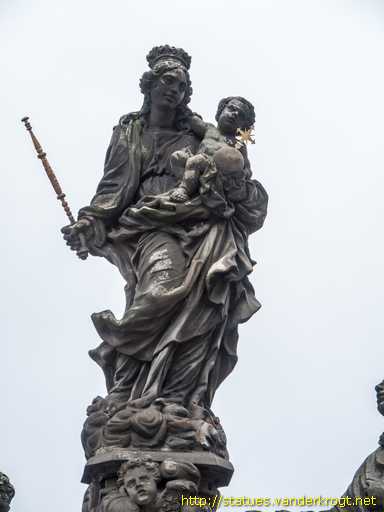
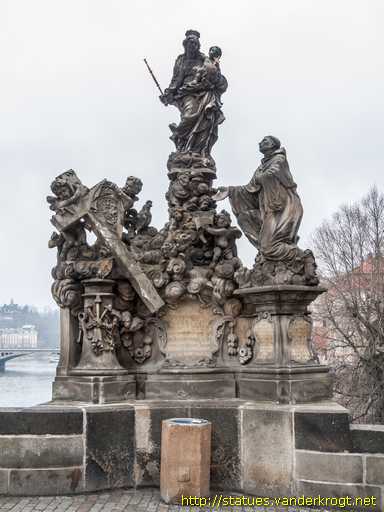
Baroque statuary, with in the center the Virgin Mary holding the infant Jesus in her arms and a sceptre. A kneeling St. Bernard, the founder of the Cistercian Order, is looking up to her on her right; an angel in front of him is holding an abbatial infula (a head cover). On the left, there are angels holding the symbols of Jesus Christ's suffering (a cross, spikes, hammer and pliers), a rooster (that crowed three times when Apostle Peter denied Christ), a veraicon (a miraculous imprint of Christ's face in Veronica's scarf) and dice (with which soldiers played for Christ's clothes).
Donated by the abbot of the Cistercian monastery in Osek, Benedikt Littwerig.
The statuary on the bridge is a copy made in 1979 by M. Vajchr, V. Hlavatý, J. and P. Vitvar, M. Tomšej, A. Viškovská-Altmanová, and J. Wolf. The original is in Gorlice at Vyšehrad.
|
|
(1253 - 1303), also known Yvo or Ives, as Erwann (in Breton) and as Yves Hélory, parish priest among the poor of Louannec, the only one of his station to be canonized in the Middle Ages. He is the patron of Brittany, lawyers, and abandoned children (Wikipedia).
Sculptor: Matthias Braun, 1711.

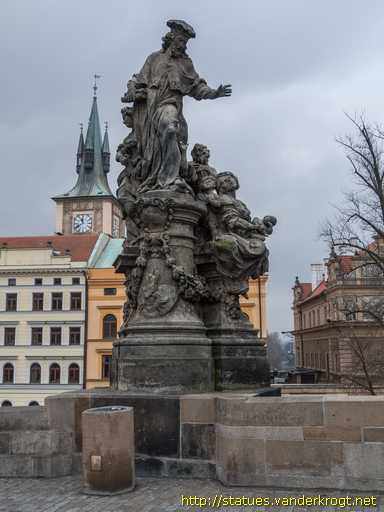
The saint is depicted as a religious judge protecting the poor against injustice of the powerful. On his right, there is an allegoric blindfolded Justice with a scale and sword. At his foot are an old man and a widow with a child who are looking up to the saint for help. On the pedestal is a relief showing a mass served for a reconciled dispute between a mother and her son.
The original was made by Matthias Braun in 1711, paid for by the Law faculty of Charles University.
The statue on the bridge is a copy made in 1908 by František Hergesel Jr. (1857-1929). The original is now in the Lapidarium of the National Museum.


Saint Dominic (Spanish: Domingo), often called Dominic de Guzmán (1170 - 1221), founder of the Friars Preachers, popularly called the Dominicans or Order of Preachers (OP)
(Wikipedia).
Saint Thomas Aquinas (Aquino 1225 - Fossanova 1274), Italian Dominican priest of the Catholic Church, and an immensely influential philosopher and theologian in the tradition of scholasticism
(Wikipedia).
Sculptor: Matĕj Václav Jäckl, 1708.

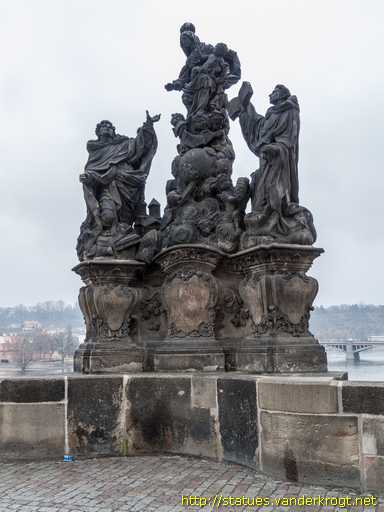
Statuary with in the center the Virgin Mary with the infant Jesus above the earth with clouds, on the ribbon a latin text IesV ..C MarIæ .... (For the glory of Jesus and Mary). Mary is giving a rosary to St. Dominic, kneeling on the left side of the pedestal and surrounded with his attributes (an abbatial infula, a head cover, and a dog with a burning torch in his mouth, the emblem of the order, and a book with the text bene est / scripsit - You wrote well). On the right, there is the creator of the scholastic philosophy, St. Thomas Aquinas, with his attributes - a book, quill, chain with a shining Sun and angel holding a beehive.
Sponsored by the Dominicans Convent of St. Giles in the Old Town of Prague.
The statue on the bridge is a copy of 1958-61 made by V. Bartůněk and S. Hanzl in 1958-61. The original is in the Lapidarium of the National Museum.
|
sanCto DoMInICo aVth orI Chronogram for 1708 |
memor esto congregationis tvæ qvam possedisti abinitio |
sanCto thoMæ aqVInatI DoCtorI Chronogram for 1708 |
positvs svmego prædicator et doctor infide et veritate |
| To St. Dominic the founder |
Mind the congregation that has been yours since the beginning |
To St. Thomas Aquinas the teacher |
I was appointed teacher and preacher of faith and truth |
The texts "We profess the crucified Christ, who disgraced all Jews" (on the left of the pedestal) and "Erected by the Preachers" (in the stylobate of the pedestal) we haven't seen.
4. Svaté Barbora, Markéta a Alžbìta / Saint Barbara, Margaret and Elizabeth
St. Barbara known in the Eastern Orthodox Church as the Great Martyr Barbara, was an early Christian saint and martyr
(Wikipedia).
St. Margaret also known as Margaret of Antioch (in Pisidia), virgin and martyr
(Wikipedia).
St. Elizabeth (1207-1231), a princess of the Kingdom of Hungary
(Wikipedia).
Sculptor: Ferdinand Brokoff, 1707.


Group of three statues:
The statuary was donated by Imperial Councilor and Associated Justice Jan Václav Obytecký of Obytec († 1707); his emblem is on the pedestal below St. Margaret and the emblem of his wife is below St. Elizabeth.
The statuary was created by Michal Jan Brokof in 1707. The statue of St. Elizabeth was probably made by Ferdinand Maxmilián Brokof; the pedestal is most likely the work of Jan Brokof.
The statue was renovated in 1852 by Josef Max.
|
orate pro nobis nunc et in hora mortis |
Pray for us now and in the hour of our death |
Sculptor: H. Hilger/Emanuel Max, 1657/1861.
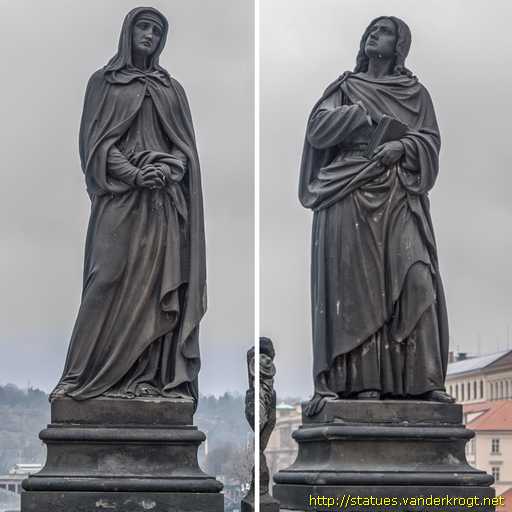
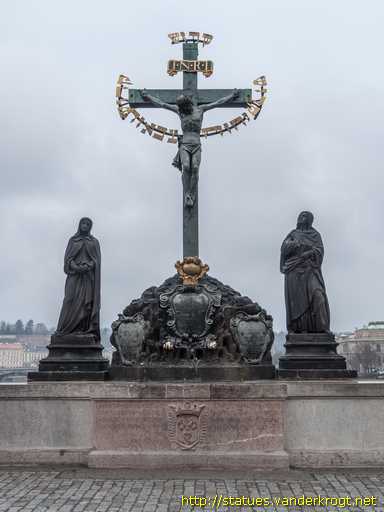
Statuary showing mount Golgotha with a crucifix, flanked by sandstone statues of the Virgin Mary and St. John the Baptist.
The bronze gilded body of Jesus Christ was made in Dresden in 1629 by bell-maker Hans Hillger based on a design of sculptor Wolf Ernest Brohn (1600-1664) and bought for Prague in 1657; two years after the statue was bought, it was placed on a wooden cross. In 1707, the wooden cross was replaced by a bronze cross mounted on the stone pedestal in the shape of Golgotha full of stone frogs, lizards and other creatures made by Jan Jiří Hermann from Dresden. The Sandstone statues of the Virgin Mary and St. John the Baptist were created by Emanuel Max in 1861 and replaced lead statues from 1666 made by Prague bell-maker Mikuláš Löw of Löwenberk (†1680) that are missing now.
The gilded inscription in Hebrew, קדוש ׀ קדוש קדוש יהוה צבאות Holy, holy, holy Lord of the Hosts, was added to the cross in 1696 and paid for with a fine charged to Elias Backoffen, a Prague Jew who had been convicted of debasing the Holy Cross by not removing his hat while passing by it. The text is derived from the words of the prophet Isaiah and reads, in English, Holy, holy, holy is the Lord of Hosts. These words, which are the origin of the Sanctus in the Mass, are an important confession of faith in the Jewish tradition as well; their placement in this context has been perceived by some as offensive. A bronze tablet with explanatory text in Czech, English and Hebrew was mounted under the statue by the City of Prague in 2000. The tablet's placement came after an American Rabbi, Ronald Brown of Temple Beth Am in Merrick, New York was passing over the bridge and noted the possibly offensive nature of the placing of the text. Upon a direct request to the mayor, the tablet was soon placed in front of the statue.
|
RE STAURATUM MDCCVII |
Restored 1707 | ||
|
Trognasobne Swatý Swatý Swatý ké cti Krysta Ukřjžovaného z pokuty proti Svatému křjži Rouhagícího se žida od Slawného Královského Tribunalu Appellationum Založené Léta Pánie 1696 dne 14. září. |
trisacivm christi crvcifixi honori ex mvlcta in sanctam crvcem blasphemi ivdæi positvm â regio tribvbali appellationvm anno domini mdcxcvi mense septembri die xiv |
Dreÿmahliges Heÿlig, heÿlig, heÿlig, zu Ehren Christi des gekreützigten auß Straff geldt Eines wider das Heÿlige Creütz Schmähenden Jüden von Einem HochLöb: Königl: Tribunal Appellationum aufgerichtet Im Jahr Christi 1696. den 14 Herbst Monath. |
Triple holy, holy, holy, for the glory of the crucified Christ paid for from a fine from a Jew blaspheming the cross, charged by the reputable royal court Founded on 14 September 1696 A.D. |
|
Carolo Adamo Baroni De Rziczan Perpetvvm In Metropolitano sacello Lavniovicz Sedi Arch. Episcopali Pragensis Hoch Monvmetvm Posvit |
Qvi Perpetvvm Hoc Lvmen Et Sacrvm Divi Wenceslai Fvndavit lecato Bono Ioannes Fridericvs ArchiEpiscopvs Anno Domini m.d.c.l.xxxi |
Donated by Prague Archbishop Jan Bedřich in 1681 in memory of Baron Karel Adam of Říčany who founded this eternal light and mass in the Metropolitan Chapel of St. Wenceslas and generously bequeathed Louňovice to the archbishopric |
The Pietà (Italian for pity) is a subject in Christian art depicting the Virgin Mary cradling the dead body of Jesus (Wikipedia).
Sculptor: Emanuel Max, 1858.

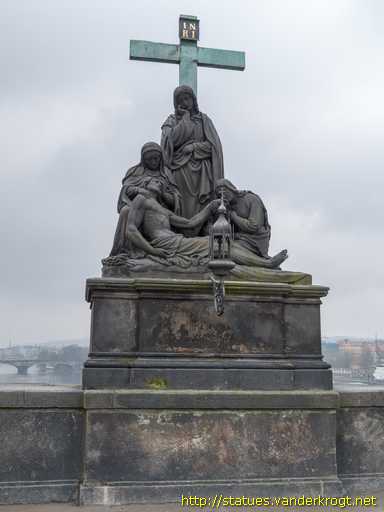
Scupture group with the Virgin Mary and St. Mary Magdalene mourning the dead Jesus Christ, St. John the Evangelist standing behind them and a crucifix with the inscription INRI towering over them.
At this position on the bridge, there was originally a wooden crucifix, which was destroyed by a flood in 1496. In 1695, a statue depicting the lamentation of Christ by Jan Brokoff was installed here; this was removed to the Monastery of Gracious Nurses under Petřín hill in Prague in 1859 and replaced by the current statue, upon commission from the Old Town's public authorities.
|
O vos omnes qui tranſitis per viam, attendite & videte si est dolor ſicut dolor meus |
O all you who pass this way, look and see whether there is any sorrow like my sorrow. |
AnnaSelbdritt, The Virgin and Child with Saint Anne - is a subject in Christian art, showing Saint Anne with her daughter, the Virgin Mary, and her grandson Jesus. This type has been quite popular in Germany from the 14th century (Wikipedia).
Sculptor: Matĕj Václav Jäckl, 1707.

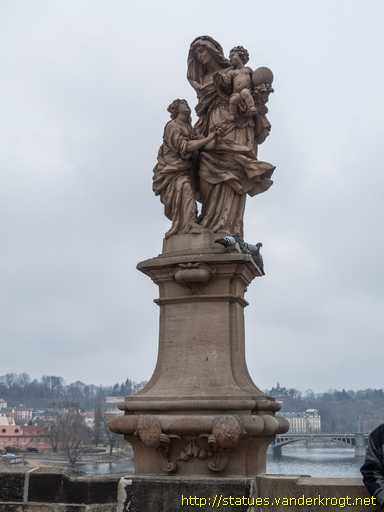
Statue of St. Anne with her daughter the Virgin Mary and grandson Jesus Christ, who is in her arms and holds the earth with a cross. With her other arm, she embraces the Virgin Mary, who is devoutly looking up to St. Anne and is handing her a bouquet of roses; Mary is portrayed as a girl, which symbolizes her chastity.
Donated by Count Rudolf of Lisov, the lord of Nový Stránov and Vtelno (†1711).
The statue on the bridge is a copy of 1999, made by V. Adamec and M. Pokorný. The original is in Gorlice at Vyšehrad.
Saint Joseph (Hebrew יוֹסֵף, "Yosef"; Greek: Ἰωσήφ), the husband of the Virgin Mary and the earthly father of Jesus Christ (in distinction to God, his "heavenly father") (Wikipedia).
Sculptor: Josef Max, 1854. - Signed: Jos: Max. inv. et fecit


Sandstone statue of St. Joseph leading the little Jesus, situated on a pseudo-Gothic base.
The statue replaced the statue of St. Joseph, made by Jan Brokof and donated by Countess Terezie Příchovská, that was put on the bridge in 1706 but was damaged, together with the statue of Pieta, by a cannonade during the revolution of 1848. This statue is in the Lapidarium of the National Museum.
|
Zum Andenken gewidmet von Jos. Bergmann Bürger und Kaufmann in Prag |
In memory dedicated by Jos. Bergmann Citizen and merchant of Prague |
Saint Cyril and Saint Methodius (Old Church Slavonic: Кѷриллъ и Меѳодїи), 9th century, Byzantine Greek brothers, missionaries among the Slavic peoples; credited with devising the 'Cyrillic' alphabet (Wikipedia).
Sculptor: Karel Dvořák, 1928/39.


Sandstone sculpture group showing the Slavic apostles St. Cyril and St. Methodius spreading the Gospel and baptizing pagan Slavs and symbolizes their mission and the idea of Slavic unity.
Donated by the Ministry of Education and Culture on the occasion of the 10th anniversary of the creation of Czechoslovakia (it is the only statue on the bridge that was paid for by the government).
Originally, here stood a statue of St. Ignatius by Ferdinand Brokoff in 1711, which was displaced by the floods of 1890 and is now in the Prague lapidarium.
Saint Francis Xavier (1506-1552), pioneering Roman Catholic missionary, co-founder of the Society of Jesus (Wikipedia).
Sculptor: Ferdinand Brokoff, Čeňek Vosmík, 1928/39.
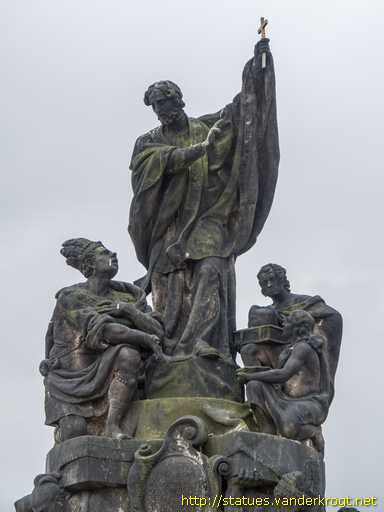

Statue of St. Francis Xavier raising a cross in front of the kneeling Hindu prince with pages and reminding the prince about the importance of faith before his baptism. In the lower part is a group of exotic princes (Chinese, Tatar, Moor and Hindu) baptized by St. Francis Xavier.
This statue is a 1913 replica by Čeňek Vosmík of Ferdinand Brokoff's original 1711 sculpture. The face of the boy below the saint's hand with a cross is actually the face of the young sculptor. The original sculpture was commissioned of the Faculty of Theology and Philosophy of Charles University, but fell into the river during the floods of 1890. It was retrieved piece by piece during 1892 - 1904 and is now in the Lapidarium of the National Museum.
 |
 |
 |
 |
|
Sancto
francisco xaverio s.i. indiarum et ia poniae apostolo theosopho gemi næ facultates theologica et philosophica universitatis pragis posu ere. mdcc xi |
In memory of St. Francis Xavier apostle of Hindus and Japanese and a beloved of God donated by the faculties of Theology and Philosophy Faculty of the University of Prague in 1711 |
|
Původni sousoši zhotovene r. 1711 ferd. maxmil. brokoffem, sřitilo se 4. záři 1890 do vltavy Peci nákladem obce pražske byl značnĕ po- škozeny opic..ial r. 1904 z řecište ...yzdvižen. V letech 1905 - 12 sochař čenek vos... ..ousoší sestail do... nil a tuto kamen...cu kopii provedl. |
Saint John the Baptist (c. 6 BC- c. 36 AD), itinerant preacher and a major religious figure who led a movement of baptism at the Jordan River. He baptized Jesus at "Bethany beyond the Jordan." (Wikipedia).
Sculptor: Josef Max, 1857. - Signed: Jos: Max. / inv. et fecit.


Statue of a blessing St. John the Baptist with a cross and shell reminding us of Christ's baptism.
Donated by Jan Norbert Gemerich of Neuberk (1796-1859). On the architectonical pedestal, there is the emblem of the donator and his wife.
The statue replaces a statue by Jan Brokoff, portraying the Baptism of Jesus by St. John, which stood in this position between 1706 and 1848. This statue was damaged during the cannonade in the revolutionary year of 1848 and removed from the bridge in 1855. The statue is now in the Lapidarium of the National Museum.
Saint Christopher (Greek: Χριστόφορος, 'Christ-bearer'), martyr of the 3rd century. Carried Christ as a child across a river (Wikipedia).
Sculptor: Emanuel Max, 1857. - Signed: Em. Max. / inv. et fec. / 1857.

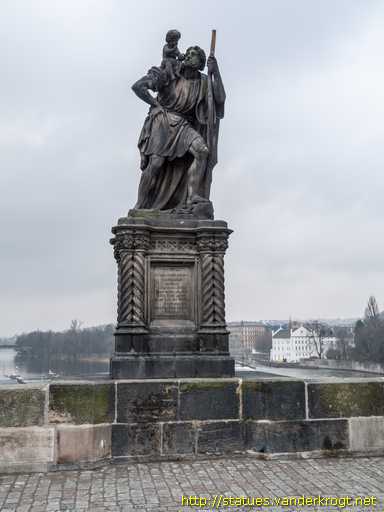
Sandstone statue of St. Christopher carrying a blessing Christ, who changed into a child, on his shoulder.
Donated by Prague magistrate Václav Vaněk, a nobleman from Rodlov (1798-1872).
|
Cleri populique Pragensis duces et cultore viribus unitis posuerunt |
Ut Jlle nos pelago saeculi jactatos brachio potenti perducat ad portum salutis quem mirum infantem felix Christophore pie portasti per fluctus Te coelestem periclitantium in undis Patronum cives precamur Pragensis. |
Anno reparatae salutis MDCCCLVII die festo S. Christophori |
May He whom you carried as the miraculous child through waves lead those who are being tossed in the sea of centuries to the haven of salvation. This is the prayer of the citizens of Prague to you, the heavenly patron of courageous sailors. |
Sculptor: Josef Max, 1853. - Signed: Ios. Max. (inv. et fecit
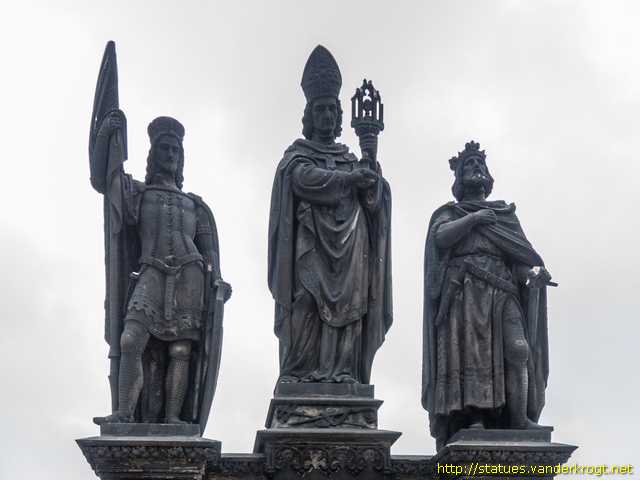
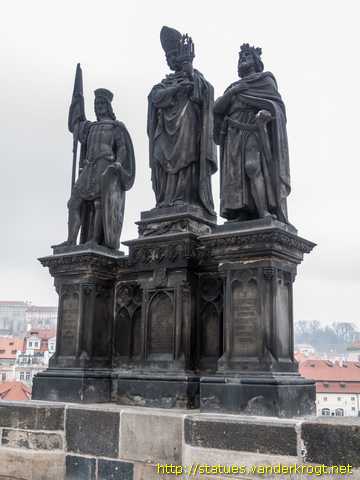
Sandstone statuary, depicting three saints on a pseudo-Gothic pedestal:
Donated by Jeroným Zeidler (1790-1834), an abbot from the Strahov Monastery. This is the third statuary here; the first one with St. Norbert and Beatified Adrian and James, created in the Brokof workshop in 1708, was destroyed by the Prussians and replaced in 1765 by the statutary of St. Norbert with angels made by Ignác František Platzer (1717-1787); both of these statuaries are now missing.
|
s. wenceslaus m. dux et patronus BOHEMIAE decus solamenque patriae. |
honori DIVI NORBERTI patriarchae sacri ac canonici ordinis praemonstratensis atque patroni regni BOHEMIAE anno salutis MDCCCLIII tertio jam posuit venerandasque ss. regum WENCESLAI et SIGISMUNDI imagines adjunxit laetis sub auspiciis reverendissimi ac magnifici d. D. HIERONYMI ZEIDLER praesulis sionei CANONIA STRAHOVENSIS |
S. SIGISMUNDUS M. rex burgundiae patronus BOHEMIAE regni christi propugnator perennis |
|
St. Wenceslas, martyr, prince and patron of Bohemia. The grace and consolation of the land |
In memory of St. Norbert, a holy patriach and canon of the Order of Premonstratensians and a patron of the Kingdom of Bohemia, in the year 1853, placed for the third time, with the statues of the venerable kings St. Wenceslas and St. Sigismund, under auspices of Jeroným Zeidler, abbot of Strahov |
St. Sigismund, martyr, king of Burgundy, patron of Bohemia and eternal warrior of the Kingdom of Christ |
Saint Francis Borgia (Gandia 1510 - Rome 1572), 4th Duke of Gandia, Grandee of Spain, (Catalan: Francesc de Borja, Spanish: Francisco de Borja), Spanish Jesuit and third Superior General of the Society of Jesus. Canonized by Pope Clement X in 1670. (Wikipedia).
Sculptor: Ferdinand Brokoff, 1710.


Sandstone statuary depicting St. Francis Borgia in a Jesuit vestment; two angels asymmetrically placed by both of his sides are holding a picture of the Virgin Mary and the Eucharist. The lower part of the pedestal shows the attributes of St. Francis Borgia - a helmet (he was a soldier), a ducal crown (he was a viceroy of Catalonia before he became a priest) and a scarlet hat (he declined the office of cardinal). The skull with a crown is to remind us of the ephemerality of this world. The upper part of the pedestal shows the emblem of the donator.
Donated by Franz of Collet, the imperial burgrave in the New Town of Vienna.
Saint John of Nepomuk (Nepomuk c. 1345 - Praha 1393), confessor of the queen of Bohemia, refused to divulge the secrets of the confessional. At the behest of King Wenceslaus of Bohemia he was thrown from the Charles Bridge in Prague and drowned. John of Nepomuk is patron saint of bridges (Wikipedia)
Sculptor: Matthias Rauchmüller, Jan Brokoff 1683. - Signed: brokoff fec
me fecit wolff hieronimvs heroldt / in nvremberg 1683
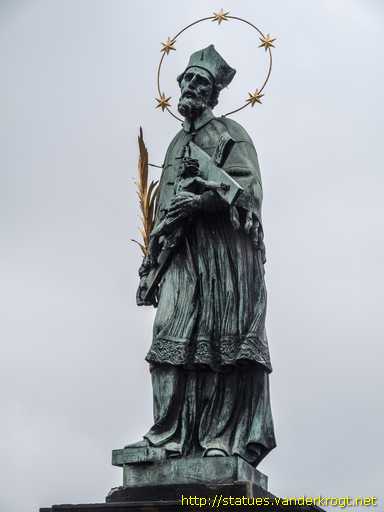
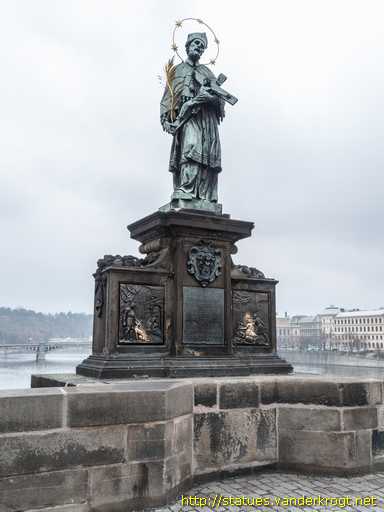
Bronze statue of St. John of Nepomuk depicted as a bearded capitulary with a five-star glory, standing on a tripartite base. The base portrays scenes from the life of St. John of Nepomuk:
In modern times it has become traditional to touch the bridge here; this is held to bring good fortune and to ensure that the visitor will return to the city of Prague.
This statue is the oldest on the bridge. The clay model of the statue was made by Viennese sculptor Mathias Rauchmüller (1645-1686), based on which Jan Brokof made a wooden model (which is now on the alter in the Church of St. John in Skalka, Prague). The statue was cast by bell-maker Wolfgang Hieronymus Heroldt in Nürnberg in 1683 and paid for by Baron Matěj Bohumír of Wunschwitz, the Lord of Ronšperc and Bezvěrov (1632-1695).

|

|
|
Divo Ioanni Nepomuceno anno m.ccc.lxxxiii ex hoc ponte deiecto. Erexit Mathias L. B. de wunschwitz. anno m.dc.lxxxiii |
Saint Ludmila (c. 860 - 921), martyr, grandmother of Saint Wenceslaus. Saint Ludmila is venerated as a patroness of Bohemia (Wikipedia).
Sculptor: Matthias Braun, ca. 1730


Statue of St. Ludmila, holding a veil, with which she was strangled, in her left hand. Her right hand is pointing out words in the Bible to teach her grandson St. Wenceslas to read.
The relief on the pedestal depicts the murder of St. Wenceslas.
The exact date and sculptor are not known, although it is believed that it was created by Matthias Braun around 1730.
The statue replaced the statuary of St. Wenceslas standing between two angels that was made by Italian sculptor Ottavio Mosto (1659-1701) in 1696 and fell into the river during the flood of 1784. The torso of the original statue made by Ottavio Mosto is now in the Lapidarium of the National Museum; some of its parts were not retrieved from the river until 2004. (See also St. Wenceslas Statue at the castle ramp
The statue on the bridge is a copy made in 1999 by Jan Kačer and M. Kačerová; the original is in Gorlice at Vyšehrad.



Saint Anthony of Padua, born Fernando Martins de Bulhões, (Lisbon c. 1195 - Padua 1231), priest and friar of the Franciscan Order, known for his preaching and expert knowledge of scripture (Wikipedia).
Sculptor: Jan Oldřich Mayer, 1707.
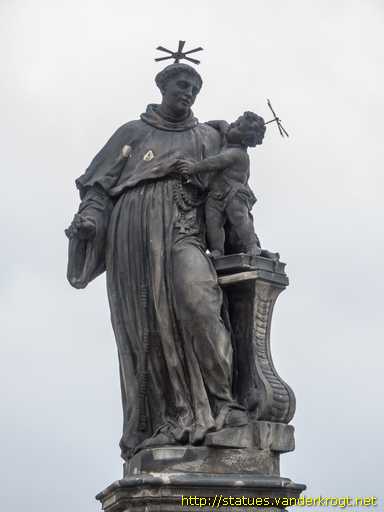

Statue of St. Anthony of Padua, dressed in a regular vestment, is standing on a simple prismal pedestal and is leaning against a voluted upstand with the infant Jesus Christ. On both sides of the statuary, there are two stone vases; the right one is adorned with reliefs showing scenes from the legend about the saint.
Donated by Kryštof Mořic Withauer, a councilor of the Prague Castle.
|
Deo InCarnato et sanCto antonIo De paDVa erIgebat et DICabat C.M.V. Chronogram 2x1707 |
To the incarnated God and St. Anthony of Padua erected and dedicated by C.M.V |
De gLoriæ zeLotes hostes IosephI CæsarIs ferI tIMore Chronogram 1707 |
The zealot of God's glory, make the enemies of Emperor Joseph tremble with fear |
Deo InCarnato sanCto antonIo De paDVa DICatqve c.m.v. Chronogram 2x1707 |
To the incarnated God and St. Anthony of Padua dedicated by C.M.V |
Saint Francis of Assisi, born Giovanni Francesco di Bernardone (1181/82 - 1226), an Italian friar and preacher. He founded among others the Franciscan Order. Saint Francis is one of the most venerated religious figures in history (Wikipedia).
Sculptor: Emanuel Max, 1855.
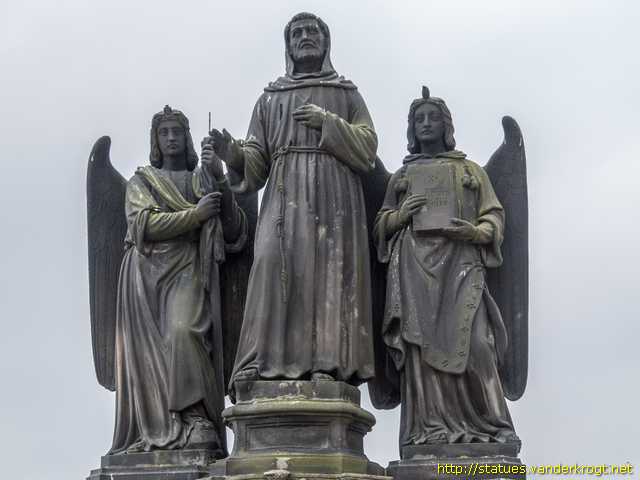

The statuary depicting three separately standing figures made in the academic Classicism style of the 19th century. In the middle, there is St. Francis of Assisie in his friar vestment standing between two angels - seraphs.
Donated by Count František Antonín Kolowrat Libštejnský (1778–1861), who ordered the work to commemorate the failed assassination of Emperor Franz Joseph I in 1853.
|
seinen engeln hat er befohlen dich zu beschützen auf allen deinen wegen psalm 90 11 |
sancto francisco seraphico ob franciscvm iosephvm imperatorem avgustvm mdcccliii divini tvs servatvm d. d. franciscvs antonivs comes kolowrat liebsteinsky eqves avrei velleris mdccclv |
anjelum svým přikázal o tobě aby tě ostříhali na všech cestách tvých žalm 90. 11 |
|
For he will command his angels concerning you to guard you in all your ways |
To St. Francis Seraph for the miraculous salvation of Emperor Franz Joseph in 1853 donated and dedicated by František Antonín Count Kolowrat Libštejnský, knight of the Order of the Golden Fleece, in 1855 |
For he will command his angels concerning you to guard you in all your ways |
Saint Jude Thaddeus, one of the Twelve Apostles (clearly distinguished from Judas Iscariot, the betrayer of Jesus) (Wikipedia).
Sculptor: Jeroným or Jan Bedřich Kohl, 1708.
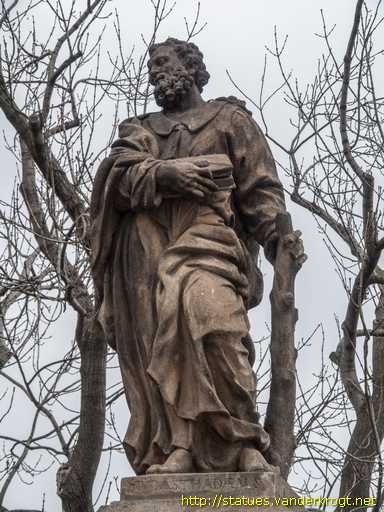

Statue of St. Jude Thaddeus holding the Gospel and a club, with which he was beaten to death by pagans, on a simple Baroque pedestal.
Donated by František Sezima, the knight of Mitrovice, Nemyšle, and Jetřichovice (1668–1720).
According to the Charles Bridge Artists Association the sculptor is Jan Oldřich Mayer.
|
|
St. Vincent Ferrer (Valencian: Sant Vicent Ferrer) (1350 - 1419), Valencian Dominican missionary and logician
(Wikipedia).
St Procopius of Sázava (died March 25, 1053), Czech saint, founding abbot of Sázava near Prague (Wikipedia).
Sculptor: Ferdinand Brokoff, 1712. - Signed: opus / Ioannis / brokoff - renov. 1957 / rud. vlach

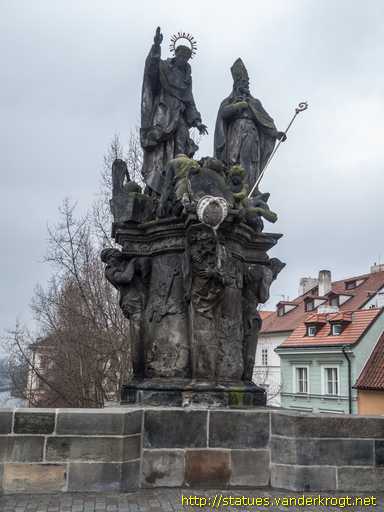
Sandstone statuary depicting St. Vincent Ferrer, in a Dominican vestment, standing on the left; by his feet there is a coffin with a dead person whom he brought back to life. The Latin inscription says resuscitavit / 40 (He resuscitated 40 [people]).
In front of St. Vincent, there is a kneeling penitent sinner; on the left, a man possessed by Satan is begging for help.
On St. Vincent's right there is St. Prokop in an abbatial vestment, holding a staff on top of the winged devil with whom Prokop ploughed a field according to legend. On the left side of the pedestal, there is the torso of a Turk and underneath the Latin inscription 8000 / sara- / cenos / ad / fidem / catho- / licam (He converted 8000 pagans to the Catholic faith); On the right side there is the torso of the weeping devil with the Latin inscription 70 daemones domuit (He tamed 70 demons); In the middle, there is the torso of a Jew with the Latin inscription 2500 / iudaeos / ad / Chris- / tum (He converted 2 500 Jews to Christ). These torsos symbolize the powers converted to the Christian faith or brought down by the two saints.
Between the torsos, there is a relief of the Last Judgment and a relief of the Ploughing of St. Prokop.
 |
 |
On the edge of the baseplate is the text convertit 100000 peccatores (He converted 100 000 sinners) and timete deum et date illi honorem qvia venit hora iudicii eius (Fear and honor God since the hour of His judgment is looking).
Donated by Romedius Josef František, Count Thun (†1719).
|
s.s. VInCentIo ferrerIo et proCopIo bInIs patronIs D.D.D. Chronogram 1712 |
To both patrons, St. Vincent Ferrer and St. Prokop |
21. Svatý Augustin / Saint Augustine
Saint Augustine (354 - 430), Bishop of Hippo Regius (present-day Annaba, Algeria), philosopher and theologian; his writings were very influential in the development of Western Christianity (Wikipedia).
Sculptor: Jeroným or Jan Bedřich Kohl, 1708.
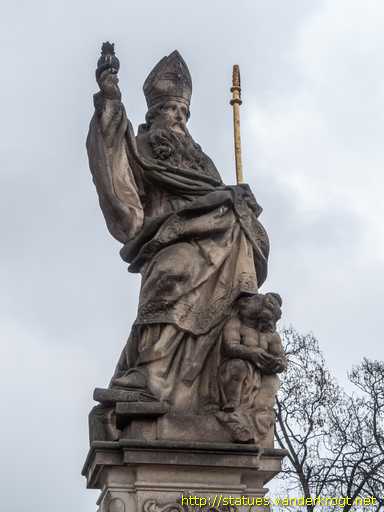

Statue of St. Augustine, dressed in an Alexandrian episcopal vestment, is holding a burning heart and stepping on heretical books (with the names of the heretics, whose teachings St. Augustine defeated - pelagius, donatlis and man...). By his left foot, there is a little angel trying to transfer a sea with a shell (it is easier to transfer a sea than to understand the secret of the Holy Trinity).
Donated by the Prague Convent of the Augustinian Order by the Church of St. Thomas.
The statue on the bridge is a copy made by J. Dušek, O. Velínský, A. Sopr and J. Hampl in 1971. The original statue is in Gorlice at Vyšehrad.
According to the Charles Bridge Artists Association the sculptor is Jan Bedřich Kohl. According to the Královská cesta site this is not likely since Jeroným worked for the Augustinian Order before and, what's more, disinherited his stepson in 1708, i.e. the year when the statue was created.
|
DoCtorVM prInCIpI |
|
DoCtorVM prInCIpI Magno Religionum Patriarchiae Divo Patri Augustino pietas filialis erexit |
To the prince among teachers, the great patriarch of the Church, St. Augustine. Erected by his proud sons |
Saint Nicholas of Tolentino (Italian: San Nicola da Tolentino, Spanish: San Nicolás de Tolentino) (c. 1246 - 1306), Augustinian, known as the Patron of Holy Souls, was an Italian saint and mystic (Wikipedia).
Sculptor: Jeroným or Jan Bedřich Kohl, 1708. - Signed: j. jiřikovský 1969


Statue of St. Nicolas of Tolentino, a benefactor of the poor, giving out bread; next to him there is an angel holding a basket with bread.
Donated by the Convent of the Augustinian Order by the Church of St. Thomas in Prague.
The statue on the bridge is a copy made by J. Jiřikovský in 1969. The original is in Gorlice at Vyšehrad.
|
fIDeLIVM ConsoLatorI |
|
DIVo Nicolao de Tolentino Prodigio sâ Sangvinis emanatione Panéqve Benedictô Miracula continua Patranti |
To the consoler of the faithful (chronogram for 1708)
To St. Nicholas of Tolentino, |
23. Svatý Kajetán / Saint Cajetan
Saint Cajetan, born Gaetano dei Conti di Tiene (also Thiene) (1480 - 1547), founder of the order of the Clerics Regular, better known as the Theatines (Wikipedia).
Sculptor: Ferdinand Brokoff, 1709. - Signed: Ioann. Brokoff / fecit / et invenit


Sandstone statue of St. Cajetan, dressed in a regular vestment, is standing in front of a tall triangular obelisk covered with clouds and the heads of angels that symbolizes the Holy Trinity. The heart on the top of the obelisk had wings but they are no longer there. The book that St. Cajetan is holding has the Latin inscription qværite / primvm / regnvm Dei / et Ivstitiam / eivs // et hæc / omnia / adjicientvr / vobis. / math. cap. 6. v. 35. (But seek first his kingdom and his righteousness, and all these things will be given to you as well. Matthew 6:33).
Donated by the Prague Convent of the Theatines (Cajetanians).
 |
 |
|
Sanctvs Caietanvs thienævs Clericorvm Regvlarvm Fvndator Apostolicæ vivendi formæ Imitator |
St. Cajetan the Theatine, the founder of the Order, who lived the life of an apostle |
Saint Lutgardis (Tongeren 1182 - 1246) was a Flemish saint, she was admitted into a Benedictine monastery of Saint Catherine near Sint-Truiden at the age of twelve, not for any vocation but because her dowry had been lost in a failed business venture (Wikipedia).
Sculptor: Matthias Braun, 1710.
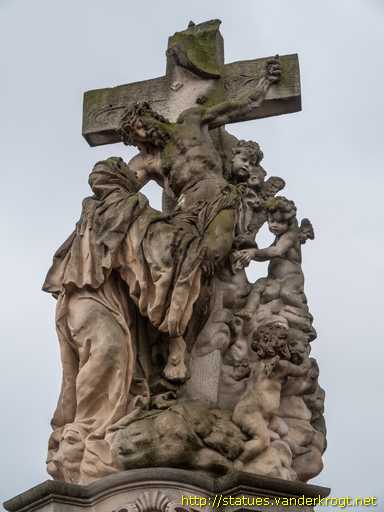

Statuary depicting St. Luitgarda who, before her death, saw the crucified Jesus Christ who embraced her, pressed her lips against his wounds and exchanged his heart for hers.
Donated by Evžen Tyttl (1666–1738), an abbot of the Cistercian Abbey of Plasy.
The statue on the bridge is a copy made by B. Rak and J. Novák in 1995. The original is in the Lapidarium of the National Museum.
|
christi cruci fixi constri cta brachio |
sancta LUTGAR- DIS ordinis cisterci- ensis |
vivificum latus exugit cor mutuans corde exbrev. cist. ad xvi iuni |
|
Embraced with the arm of the crucified Christ |
St. Luitgarda from the Cistercian Order |
The vivified side gave a heart for another heart. From the Cistercian breviary for 15 June |
Saint Philip Benizi de Damiani (sometimes St Philip Benitius, Spanish: Felipe Benicio) (1233 - 1285), General Superior of the Order of the Servites (Wikipedia).
Sculptor: Bernhard Michael Mandl, 1714.
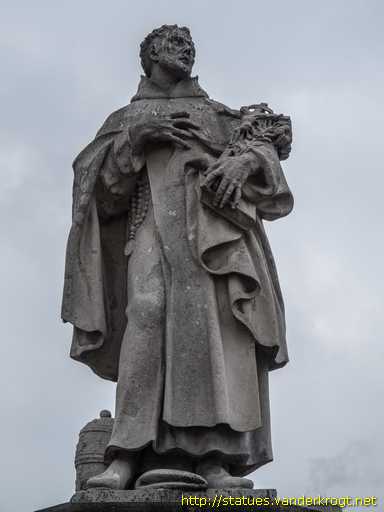

Statue made from Salzburg marble (the only marble statue on the bridge) of the prior-general of the Servites, St. Philip Benizi, dressed in a regular vestment, with a cross, branch and book and in an ecstatic pose. By his feet, there is a papal tiara to remind us of his refusal to become a pope.
Donated by the Prague Convent of the Servites.
The statue was renovated by M. Tomše and J. Kaifosz in 2000; the new pedestal, made of four pieces of sandstone from Božanov, was created by J. Diviš.
|
S. PHILIPPUS BENITIUS ORDINIS SERVORUM R.V.M. Quintus Generalis in humilitate placuit DEO |
St. Philip Benizi, the fifth prior-general of the Servites, was loved by God for his humbleness |
Saint Adalbert (c. 956 - 997), bishop of Prague and a missionary, was martyred in his efforts to convert the Baltic Prussians. Patron saint of Bohemia, Poland, Hungary and Prussia (Wikipedia).
Sculptor: Michael and Ferdinand Brokoff, 1709. - Signed: reprodukci provedl / Hořínek v a hořínek k / 1973
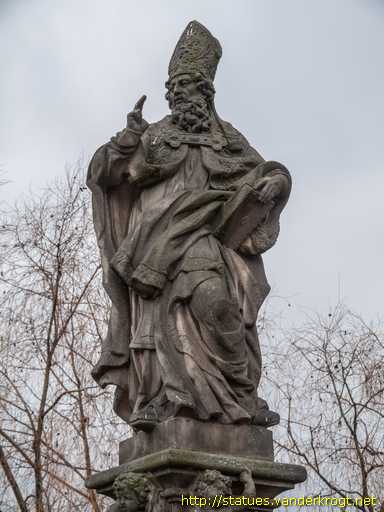
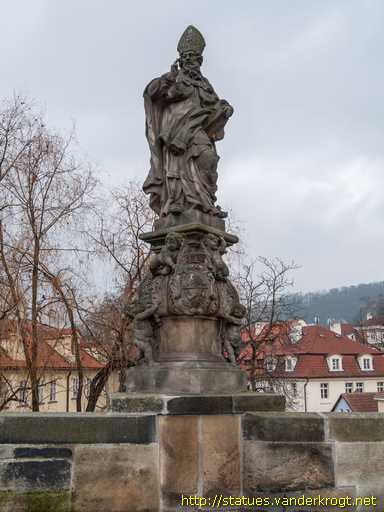
Statue of St. Adalbert, in a richly draped vestment blessing the Czech Lands after his return from Rome. His hand is holding the Gospel that he preached to the Prussian Slavs and Hungarians. The pedestal is adorned with acanthus plants, angels and the emblem of the donator.
|
MarCVs de recIæ antIqVæ ConsV pVbLICo |
IoanneLLI VrbIs Pragenæ LarIs CVLtVI eXposVIt |
|
Erected by Marcus de Joanelli, a councillor of the Prague Old Town, to publicly honor St. Adalbert (Chronogram 1709) | |
Saint Vitus from Sicily, died as a martyr during the persecution of Christians by co-ruling Roman Emperors Diocletian and Maximian in 303. Vitus is counted as one of the Fourteen Holy Helpers (Wikipedia).
Sculptor: Ferdinand Brokoff, 1714. - Signed: opus / Ioan. Brokoff

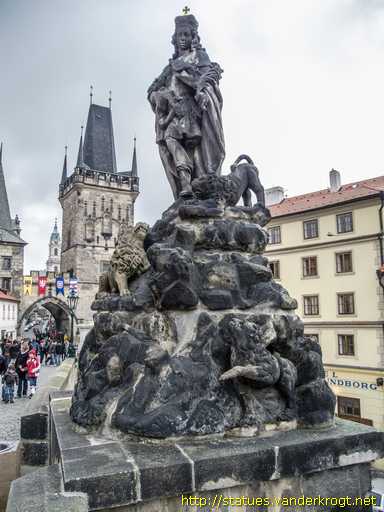
Statue of St. Vitus as a Roman soldier (he lived in Sicily in the 3rd century) with a medieval ducal hat. He is standing on a rock with caves out of which peaceful-looking lions come out (according to legend, the saint was thrown to the lions but tamed them and they laid down by his feet). The medieval hat symbolizes the relationship between the saint and medieval Bohemia.
Donated by Matyáš Adalbert Macht of Lowenmacht, dean of the Chapter of Vyšehrad.
| S. VITUS |
St. John of Matha (12th century), founder of the Order of the Most Holy Trinity. He was urged by a vision during his first mass to dedicate his life to the service of the captive Christian slaves. He offered service to and was instructed by the hermit, Saint Felix of Valois
(Wikipedia).
St. Felix of Valois (1127 - 1212), hermit and a co-founder (with Saint John of Matha) of the Trinitarian Order
(Wikipedia).
Beatified Ivan is a legendary hermit, supposedly the first one in the Czech Lands, and a Czech patron. He lived in the Beroun Region in the second half of the 9th century.
Sculptor: Ferdinand Brokoff, 1714. - Signed: Opus Ioann. Brokoff


Sandstone statuary, also called the Statuary of the Trinatarians or the Turk. Depicted are three saints, standing on a rock:
Below there is a stag (to remind us that all three saints used to be hermits). The pedestal of the statuary is made in the shape of a huge rock with a cave. Three imprisoned Christians are guarded by a dog and a Turk with quirts (originally with a spear), a figure from many Prague legends. Above the window to the cave, there is a trisectional cartouche with an angel setting both prisoners free, the emblem of the donator and his wife and the Latin inscription Ioan. / franCIscVs / e / CoMItIbVs / De thVn / ff (Jan František Count Thun; chronogram 1714.
Donated by Jan František Josef, Count Thun (1686–1720); It was created to honor the two founders of the Trinitarian Order that specialized in buying and setting free Christian slaves captured by the Muslims. It is still not clear why the Slavic patron St. Ivan is there with the two French saints.
 |
 |
|
LIberata a ContagIone patrIa et ConCLVs CVM gaLLIs paCe |
iiie brückenstatuen wurden im jahre 1854 durch bürgermeister Do: wanka restaurirt |
|
When the country was rid of the plague, and peace was signed with the French (Chronogram 1714) |
The statues on the bridge were renovated in 1854, by Dr. Wanka, mayor |
Saints Cosmas and Damian (Greek: Κοσμάς και Δαμιανός) (d. ca. 287), twins and early Christian martyrs; practised the art of healing in the seaport of Aegea (modern Ayas), then in the Roman province of Syria. Accepting no payment for their services led to them being named "Ανάργυροι" (Unmercenary); it has been said that, by this, they attracted many to the Christian faith (Wikipedia).
Sculptor: Jan Oldřich Mayer, 1708.

Three separate figures are standing on a large trisectional pedestal. In the middle, there is the statue of Jesus Christ Salvator Mundi (the Savior of the World) made in the style of Central European Realism. St. Cosmos (on the left) and St. Damian (on the right) are dressed in the typical attire of professors of the Prague University. They are holding palm branches, the symbol of martyrs, and medicine containers.
Donated by the Medicine Faculty of the Prague University (both saints are patrons of physicians).
The statue was obviously being restored when we visited Prague
|
Inter DIVos hIppoCra tI CosMæ |
IesV ChrIsto orbIs MeDI Co |
pIoqVe fratri CoeLIgaLe no DaMI ano |
|
To Cosmas, the Hippocrates among the saints (Chronogram 1709) |
To Jesus Christ, the healer of the world (Chronogram 1709) |
To the pious brother Damian, the Galen from Heaven (Chronogram 1709) |
Saint Wenceslas (c. 907 - 935), duke of Bohemia, raised as Christian by his grandmother, Saint Ludmila. He was murdered in 935 on his way to church. Patron saint of the Czech people and the Czech Republic (Wikipedia).
Sculptor: Josef von Führich and Karel Böhm, 1858. - Signed: Inv. J. Fürich - Böhm scp. 1858
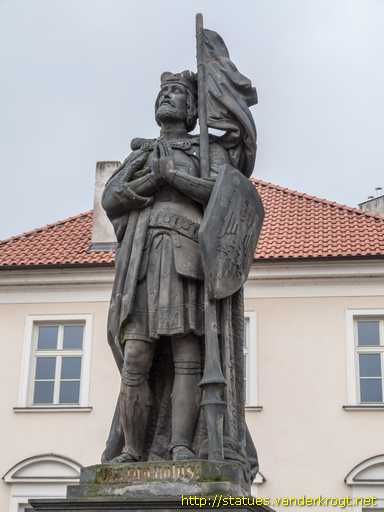

Sandstone statue of St. Wenceslas is standing on a prismal pedestal.
Based on a design of painter Josef Führich (1800-1876) and donated by Pavel Alois Klár (1801-1860), the son of the founder of the Klár Institute of the Blind in Prague, Alois Klár (1763-1833), to commemorate the 25th anniversary of the foundation of the institute.
At the foot of the statue the text ORA PRO NOBIS and:
|
In memoriam festivitatis primae lustri quinti post fundationem instituti coecorum adultorum in Bohemia celebratæ Pragæ iv. in Octob. mdccclvii |
In memory of the first celebration of twenty-five years since the foundation of the Institute of Blind Children in Prague held on 4 October 1857 |
Your banner here? Click for information.